Biodegradation
What is Compostable Biodegradation and Disintegration Testing?
This testing evaluates the biodegradation properties and disintegration capabilities of plastics and other materials under composting conditions. It aims to minimize environmental impact and contribute to the development of renewable materials. The test measures the aerobic biodegradability and composite biodegradability of plastic materials, assessing their disintegration under simulated composting conditions in both laboratory and pilot-scale settings.
Test Items
| classification | Standard name | ||||
|---|---|---|---|---|---|
| Composting biodegradability test | Industrial composting conditions |
KS M ISO 14855 – 1 Measurement of aerobic biodegradability of plastic materials under composting conditions, through the analysis of emitted carbon dioxide. |
|||
| Home composting conditions |
AS 5810 Biodegradable plastics suitable for home composting |
||||
| Composite biodegradability test | Biodegradability after hydrolysis and composting |
ISO 21701 Textiles - Test method for accelerated hydrolysis of textile materials and biodegradation under controlled composting conditions of the resulting hydrolysate |
|||
| Oxidative biodegradability |
ASTM D6954 Standard Guide for Exposing and Testing Plastics that Degrade in the Environment by a Combination of Oxidation and Biodegradation |
||||
| division | Preprocessing method | Exam period | Required sample quantity | Test temperature | Evaluation method |
|---|---|---|---|---|---|
| General composting biodegradation | smash | 45~180 days | About 200g or more | 58 ℃ | Carbon dioxide emissions |
| Composite biodegradation | Grinding after hydrolysis | 45 to 180 days after pretreatment (hydrolysis or oxidative degradation to the point of molecular weight reduction) | |||
| Crushing after photo-oxidation decomposition |
| classification | Standard name | |
|---|---|---|
| Lab-scale biodegradability test |
KS T ISO 20200 Measurement of the degradation of plastic materials under laboratory-scale simulated composting conditions. |
|
| Pilot scale biocollapse test |
KS M ISO 16929 Measurement of the degradation of plastic materials under prescribed composting conditions through pilot-scale testing. |
|
| division | Exam period | Required sample quantity | Evaluation method |
|---|---|---|---|
| Lab-scale biodegradability test | 4~12 weeks | About 5g or more | Weight reduction rate, visual evaluation |
| Pilot scale biocollapse | About 1 kg or more |





What is Environmental Impact Assessment?
After completing biodegradation and disintegration tests, this process evaluates the environmental impact of any residual materials. It measures the effect of remaining residues on the germination and early growth of seedlings from two higher plant species, determining the environmental suitability of the material.
Test Items
| classification | Standard name | |
|---|---|---|
| Plant toxicity |
OECD 208 Terrestrial Plant Test : Seedling Emergence and Seedling Growth Test |
|
|
EN 13432 (Annex E) Packaging - Requirements for packaging recoverable through compositing and biodegradation - Test scheme and evaluation criteria for the final acceptance of packaging |
||
| division | compost | Exam period | Evaluation method |
|---|---|---|---|
| Plant toxicity assessment | The test is conducted using compost that has completed the biodegradability test. | 2~3 weeks | Seed germination rate Biomass weight |

Plant toxicity evaluation in progress
- Sewage treatment conditions: Water flea
- Marine conditions: Please inquire separately about luminescent bacteria
What is General Soil Biodegradation Testing?
This test measures the final aerobic biodegradability of plastics and other materials under soil conditions. Using a closed respirometer system, it tracks oxygen consumption or carbon dioxide generation. The results help minimize environmental impacts and support the development of renewable materials.
Test Items
| classification | Standard name | |
|---|---|---|
| General soil biodegradability test |
KS M ISO 17556 Plastics - Measurement of the final aerobic biodegradability in soil through the measurement of oxygen consumption or carbon dioxide production using a closed respiration system. EN 17033 - Plastics - Biodegradable mulch films for use in agriculture and horticulture - Requirements and test methods EN 14995 - Plastics - Evaluation of compostability - Test scheme and specifications |
|
| division | Required sample quantity | Preprocessing method | Test temperature | Exam period | Evaluation method |
|---|---|---|---|---|---|
| General soil biodegradability | About 50g or more | smash | 20~28℃ | 3~24 months | Oxygen consumption or carbon dioxide production |



*Oxygen consumption
*Measurement of carbon dioxide emissions


What is Anaerobic Biodegradation Testing?
This test evaluates the biodegradability of plastics and other materials under anaerobic (oxygen-free) conditions. It measures the methane emissions produced as waste decomposes in landfills or anaerobic digesters. This helps identify the biodegradation characteristics of materials in anaerobic environments and assess their environmental compatibility.
Test Items
Anaerobic biodegradability test
| classification | Standard name | |
|---|---|---|
| Anaerobic biodegradability test |
ASTM D 5511 Standard Test Method for Determining Anaerobic Biodegradation of Plastic Materials Under High-Solids Anaerobic-Digestion Conditions KS T ISO 15985 Plastics - Determination of anaerobic biodegradation and degradation of solids under anaerobic conditions, using biogas emission analysis. |
|
BMP (Biochemical Methane Potential) TEST
| classification | Standard name | |
|---|---|---|
| Waste |
ISO 11734(2008) Evaluation of the "final" anaerobic biodegradability of organic compounds in degradation sludge (measuring biogas production). OECD 311(2006) Anaerobic Biodegradability of Organic Compounds in Digested Sludge: by Measurement of Gas Production |
|
What is Aquatic Biodegradation Testing?
This test assesses the biodegradability and disintegration of plastics and other materials in river and wastewater treatment environments. It measures the decomposition capacity of materials under simulated wastewater treatment and marine conditions, helping prevent the release of pollutants into rivers and oceans, thereby contributing to environmental protection.
Test Items
Sewage simulation biodegradability test
| classification | Standard name | |
|---|---|---|
| Sewage simulation biodegradability test |
KS I ISO 7827 Water quality - Evaluation of the final aerobic biodegradability of organic materials in liquid media - Dissolved organic carbon analysis method. KS I ISO 9408 Water quality - Evaluation of the final aerobic biodegradability of organic compounds in liquid media by measuring oxygen demand using a closed respiration measurement system. KS I ISO 9439 Water quality - Evaluation of the final aerobic biodegradability of organic compounds in liquid media - Carbon dioxide production test method. KS M ISO 14851 Measurement of the final aerobic biodegradability of plastic materials in aqueous media - Oxygen consumption measurement using a closed respiration system. KS M ISO 14852 Measurement of the final aerobic biodegradability of plastic materials in aqueous media - Carbon dioxide emission quantification method. KS I ISO 9408 Water quality - Evaluation of the final aerobic biodegradability of organic compounds in liquid media by measuring oxygen demand using a closed respiration measurement system. OECD 301 A, DOC Die-Away Test OECD 301 B, CO2 Evolution Test(Modified Sturm Test) OECD 301 C, Modified MITI Test(Ⅰ) OECD 301 F, Manometric Respirometry Test |
|
- Target product


- detergent
- Laundry detergent
- Kitchen detergent
- Fabric softener
- Snow removal agent
- lubricant
| classification | Standard name | |
|---|---|---|
| Marine Simulated Biodegradability Test |
ASTM D6691 Standard Test Method for Determining Aerobic Biodegradation of Plastic Materials in the Marine Environment by a Defined Microbial Consortium or Natural Sea Water Inoculum ASTM D7991-22 Standard Test Method for Determining Aerobic Biodegradation of Plastics Buried in Sandy Marine Sediment under Controlled Laboratory Conditions ISO 23977 : Plastics - Determination of the aerobic biodegradation of plastic materials exposed to seawater Part 1: Method by analysis of evolved carbon dioxide Part 2: Method by measuring the oxygen demand in closed respirometer ISO 19679 : Plastics - Determination of aerobic biodegradation of non-floating plastic materials in a seawater/ sediment interface - Method by analysis of evolved carbon dioxide ISO 18830 : Plastics - Determination of aerobic biodegradation of non-floating plastic materials in a seawater/ sandy sediment interface - Method by measuring the oxygen demand in closed respirometer OECD 306: Biodegradability in Seawater ISO 23832 : Plastics - Test methods for determination of degradation rate and disintegration degree of plastic materials exposed to marine environmental matrices under laboratory conditions |
|
| Sample volume | Exam period | Evaluation method |
|---|---|---|
| 100g or more | It varies according to each standard. | Measuring biodegradability by carbon dioxide emissions and oxygen consumption |